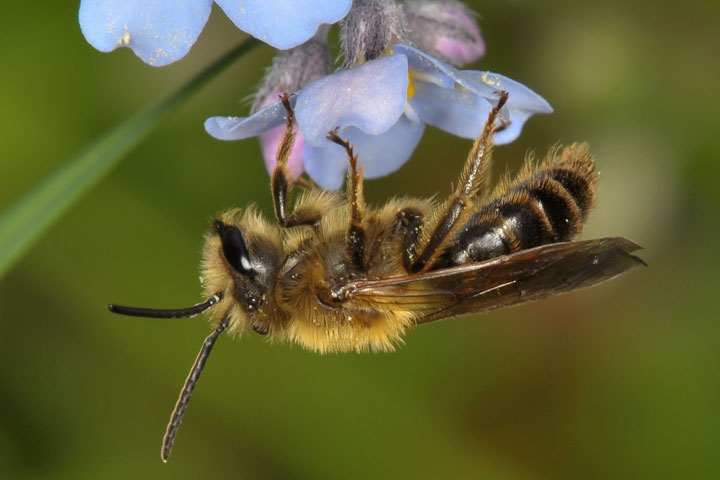Solitary Bees
The social bees (bumble bees and honey bees) get good press—everyone knows about them—but, locally they are neither the only nor the preponderance of species. That honour falls to the many kinds of solitary bee: bees for which every female is fertile, and (typically) inhabits a nest she constructs herself. This is a very different behavior than that of the social bees where a large colony of bees depends upon a single breeding female: the queen. Solitary bees have no worker bees, and typically produce neither honey nor beeswax. But, beyond that they come in a rich variety of types and display a rich variety of behaviours.
The Canadian Wildlife Federation lists over a dozen types at Some Bee Species in Canada. It is not yet clear how many different species are found locally, but three different groups (each with many members) are shown below: sweat bees, mining bees, cuckoo bees.
Sweat bees
Lasioglossum spp., Halictus spp.
 A female sweat bee (Lasioglossum sp.). Sweat bees are so named because, being attracted to salt, they are attracted to human sweat. The Lasioglossum bees are both common and easily missed as they are small and so easily overlooked. Its nests are often found in the ground. These bees do not have the specialized structures on the hind legs for carrying pollen, but pollen can be picked up by any hairy surface, such as legs or the lower (ventral) surface of the abdomen. In this picture, the bee is visiting an orange hawkweed. ID by RWT
A female sweat bee (Lasioglossum sp.). Sweat bees are so named because, being attracted to salt, they are attracted to human sweat. The Lasioglossum bees are both common and easily missed as they are small and so easily overlooked. Its nests are often found in the ground. These bees do not have the specialized structures on the hind legs for carrying pollen, but pollen can be picked up by any hairy surface, such as legs or the lower (ventral) surface of the abdomen. In this picture, the bee is visiting an orange hawkweed. ID by RWT
 A female sweat bee (Halictus sp.) visits blossoms of the white sweetvetch (Hedysarum sulphurescens). The pollen has built up on its back leg and lower abdomen. ID by MB
A female sweat bee (Halictus sp.) visits blossoms of the white sweetvetch (Hedysarum sulphurescens). The pollen has built up on its back leg and lower abdomen. ID by MB
Mining bees
Andrena spp.
 A female mining bee (Andrena sp.). Each mining bee female digs her own individual burrow to rear her own young. This one is collecting nectar from yarrow. ID by RWT
A female mining bee (Andrena sp.). Each mining bee female digs her own individual burrow to rear her own young. This one is collecting nectar from yarrow. ID by RWT
 A female mining bee (Andrena sp.) has extended its tongue into the yarrow. ID by RWT
A female mining bee (Andrena sp.) has extended its tongue into the yarrow. ID by RWT
 Mining bee (Andrena sp.). ID by MB
Mining bee (Andrena sp.). ID by MB
 Mining bee (Andrena sp.).
Mining bee (Andrena sp.).
 Mining bee (Andrena sp.).
Mining bee (Andrena sp.).
 Mining bee (Andrena sp.).
Mining bee (Andrena sp.).
 Mining bee (Andrena sp.).
Mining bee (Andrena sp.).
Cuckoo bees
Nomada spp.
 A cuckoo bee (Nomada sp.).
A cuckoo bee (Nomada sp.).
 Another cuckoo bee (Nomada sp.).
Another cuckoo bee (Nomada sp.).
 The cuckoo bee (Nomada sp.) parasitizes other bees, especially the mining bees ((Andrena spp.) by laying its eggs in their nests. This female cuckoo bee is visiting yarrow. ID by RWT
The cuckoo bee (Nomada sp.) parasitizes other bees, especially the mining bees ((Andrena spp.) by laying its eggs in their nests. This female cuckoo bee is visiting yarrow. ID by RWT
Identifications:
RWT = Robbin Thorp
MB = Matthias Buck
![]()